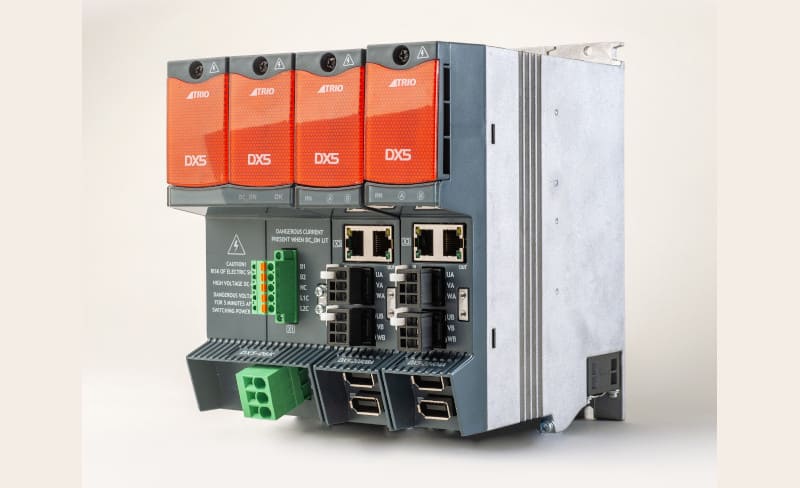Trio Motion Technology has launched a multi-axis servo drive to provide precision motion coordination for space critical, lower power machines up to 750W. The new DX5 servo drive is designed to be cost effective for machine builders who need multi-axis EtherCAT performance control, and a zero-stacking gap and compact dimensions enable a small footprint.
The DX5 multi-axis servo drive is aimed at OEMs designing machines for applications such as laser, plasma, or water cutting, between two and 16 axes. The multi-axis drive is also intended for packaging machines with lower power requirements, including form fill seal, and labelling applications.
Motion control performance in a compact footprint
Multi-axis synchronisation includes EtherCAT control performance down to 250μs, with 350% overload for pulse duty cycles. The DX5 multi-axis servo drive also supports 20-bit single turn or 23-bit multi-turn absolute encoders. These motion performance characteristics enable high speed and precision control with optimised multi-axis coordination across the machine, enabling increased throughput with maximum production quality.
The compact, multi-axis servo drive is designed as a space-saving dual axis module in 750W and 400W frame sizes. A zero-stacking gap minimises footprint when adding up to a maximum of eight axes at 750W, or 16 axes at 400W. A single, dual axis module measures 40mm wide x 205mm high x 203mm deep. A full eight axes at 750W extends width to just 240mm including power stage, while a full 16 axes at 400W only extends width to 400mm including power stage. These compact dimensions make DX5 among the smallest multi-axis servo systems available. The 750W drive supports 750W and 400W servo motors, and the 400W drive supports 400W, 200W and 100W servo motors.
Designed for energy and cost savings
The DX5 multi-axis servo drive is also highly energy efficient, providing savings for end users across the lifetime of the machine as a result of the integrated DC Bus regenerative energy system. The DC link absorbs motor braking energy, reusing it across the machine’s axes. This system reduces cost for the machine user and contributes to their environmental commitment.
Cost saving is also achieved by removing I/O from individual drive axes with functionality integrated instead into the Motion Coordinator. This approach achieves one of the lowest cost-per-axis counts between two and eight axes up to a 750W requirement, or up to 16 axes at 400W.
Reliable multi-axis synchronisation and fast development
Plug and play functionality is achieved with a matched servo motor – the low inertia, high speed Trio MXL. Trio’s free to download, simple to use Motion Perfect PC tool enables fast autoconfiguration, while seamless integration with a Trio controller also ensures trouble-free machine set-up. Optimised motor, drive and controller compatibility provides long-term reliability for end users, enhancing machine productivity by minimising downtime.
It’s quick to programme Trio’s controllers for multi-axis synchronisation, with a choice of IEC 61131-3 languages, PLCopen, as well as Trio’s intuitive, text-based Motion-iX language. If required, additional control functionality can also be added via Trio’s Flexslice I/O system with individual modules simply clicking into place.
“The DX5 multi-axis servo drive is for machine builders who need high performance motion synchronisation in a lower power, compact and cost effective package,” says Trio’s President, Tom Alexander. “The multi-axis system provides high speed and precision EtherCAT motion control, offering what we believe is the most price-competitive multi-axis servo package up to 750W.”

